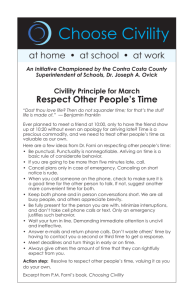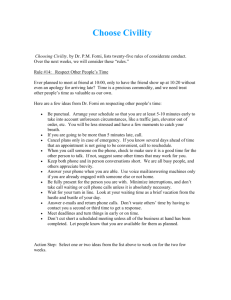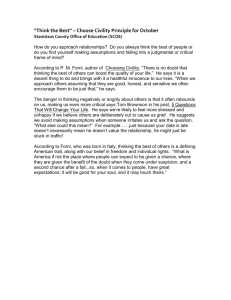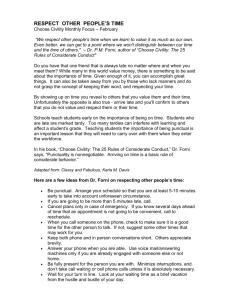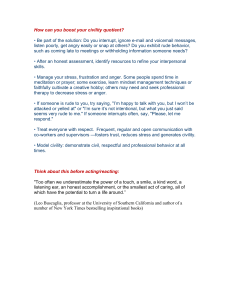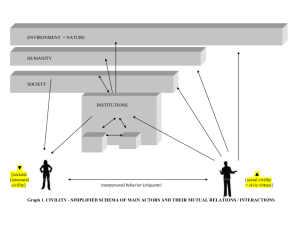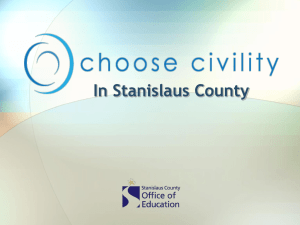1
advertisement
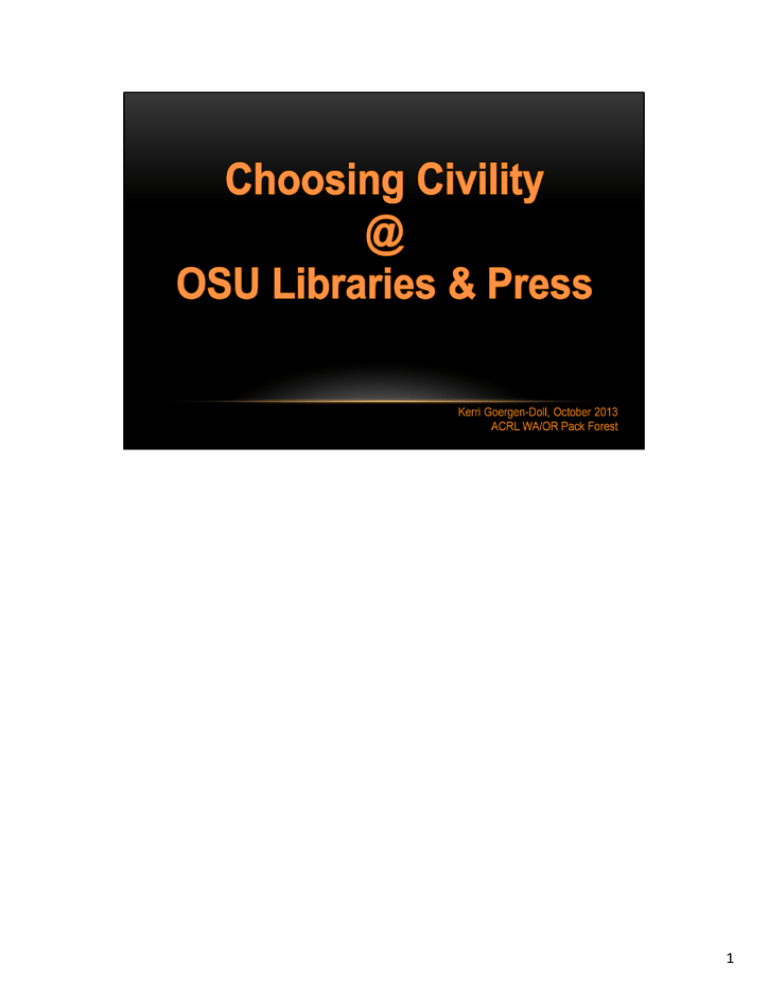
1 Photo credit: http://www.flickr.com/photos/ruminatrix/3755296805/ “Words must become reality.” Start out with a bit of soapboxing followed by an introduction to some of the work of the civility committee, and highlight lessons we’ve learned that you should consider before starting your own civility campaign. If you need me to clarify anything as I go along, please feel free to do so. Questions are my favorite part of a presentation so I’ve saved that part to the last. If you think your memory will fail you before that time, please feel free to ask. 2 Photo credit: http://www.flickr.com/photos/boston_public_library/3531511104/ The Center for Independent Studies in Australia investigated civility in terms of how it impacted the quality of life for Australians. The paper, titled Six Questions about Civility, was written by Nicole Billante and Peter Saunders in 2002. The paper discusses six basic questions and compliments the discussion with excerpts from focus group members. I’m not going to go over all 6 questions, but I’ve provided the citation on your handout for your future reading enjoyment. But I do reserve the right to insert comments from the article further along in the presentation. The fourth question addressed in the paper is “Has civility declined?”. The authors looked back through Australian newspapers back to 1950, and found that similar concerns about public behavior exist through this time period. This only indicates that at each point that an article was written, there was indeed a lapse in civility, but overall we can’t assume that things have gone from bad to worse. The article cites a 1996 poll of Americans that found 89% of respondents thought that incivility was a serious problem and that 78% thought things had worsened over the last ten years. The CIS focus groups participants that were identified as middle aged or elderly indicated they felt that “norms of politeness and good behavior had frayed during their lifetimes”. A middle aged male from the focus group made the following comment: “They’re not taught the manners whereas years ago, I mean we had to show 3 the manners or it was go to your room and that was it”. I think we can agree that every generation has the same thoughts. “When I was that age, I had to do X or else!” This does not indicate that the end of civility is near. The authors working hypothesis for this study is that people are willing and able to behave in a civil manner, but the clarity of the norms and acceptance level of some of those civil norms is fuzzy. Billante, N. & Saunders, P. & Centre for Independent Studies (Australia). (2002). Six questions about civility. St Leonards, N.S.W : Centre for Independent Studies 3 Photo credit: http://www.flickr.com/photos/grizdave/3251937629/ Fuzzy Norms make it hard to know what the “rules” are around being civil in today’s society. The status of women has changed so that it is no longer a norm for a man to automatically give up a seat for a woman. We live a lot longer and so age protocols are changed. 4 Photo credit: http://www.flickr.com/photos/michaelsgalpert/2061053781/ and http://www.flickr.com/photos/seattlemunicipalarchives/2851696372/ Activity to demonstrate fuzzy norms. Determine how many people have ridden on public transportation. The bus is full meaning all seats are taken. It’s after work and most people are tired. At the next stop, a woman with gray hair boards the bus with a walker. You are on an aisle seat, do you give up your seat for her? Same bus, only this time a woman with gray hair boards the bus wearing a business suit and running shoes. Do you give up your seat for her? What if the scenarios were changed so that it was a gray haired man that got on the bus? What if you got on a full bus and a 15 year old offers you their seat? Do you take it? Do you think norms have changed since the 1950’s? 5 Photo credit: http://www.flickr.com/photos/grizdave/3251937629/ What other norms have lost their clarity for you? What about food and drink in the library? What about noise levels? What about not taking calls during dinner? I used to have to let the answering machine take the call if my friends called during dinner. Now, we have no boundaries concerning when it is or is not a good time to take a call because the phone can fit in our pockets. When you are helping someone get a study room or search a database, it feels pretty rude when the person you are helping answers a call right as you are speaking to them. 6 Photo credit: http://www.flickr.com/photos/f-ilia/4704232058/ In the book Civility: Manners, Morals, and the Etiquette of Democracy, Stephen L. Carter suggests that even though there are fuzzy norms and we might not have firm rules on the characteristics of who we should give a seat to on a bus. We should use the norm that if the person appears to need the seat more than we do in that moment in time, we should offer to give up our seat to them. Stephen also suggests that some rules of civility from the 1950’s are sexist by today’s standards. For example, all men were to give their seat on the bus to any woman. He recommends that we should discover which rules are worth saving and resurrect them by today’s standards. So all of us look to give up our seat to any person that is in more need than we are. In the book The New Basic Black, Karen Grigsby Bates and Karen Elyse Hudson also echo Stephen Carters call to think about the comfort of others. “Manners and etiquette are, simply put, about being comfortable and being confident enough to make others feel comfortable, too.” Bates, K. G., & Hudson, K. E. (2006). The new basic black: Home training for modern times. (2nd ed.). New York: Doubleday. Carter, S.L. (1998). Civility: Manners, morals, and the etiquette of democracy. Basic Books: New York. 7 7 Photo credit: http://krieger.jhu.edu/civility and http://www.barnesandnoble.com/w/civility-solution-pmforni/1101904498?ean=9781429945578 Dr. P.M. Forni visits OSU in 2011 where multiple library staff members hear him lecture. Book club-summer 2011 initiated from those that attended Dr. Forni’s lecture and felt we needed to do more about civility on campus. From the book club meetings, three in total, we brainstormed ideas we wanted to put into action. Forni, P.M. (2008). The civility solution. St. Martin’s Press, New York. 8 But really, why have a civility committee? Everything we needed our students and faculty to learn they learned in kindergarten. Or did they? Even if they did attend kindergarten they learned the social norms of their society at that point in time. Kindergarten was established in the early 1800’s and over time there have been changes to the curriculum. In the south there is also something known as home training where you are taught manners like standing up when your grandmother comes into the room. One of our committee members grew up with home training, but the manners she was taught might not be the same manners taught to the youth of today. "All I Really Need To Know I Learned In Kindergarten" by Robert Fulghum Most of what I really need To know about how to live And what to do and how to be I learned in kindergarten. Wisdom was not at the top Of the graduate school mountain, But there in the sandpile at Sunday school. Fulghum, R. (2003). All I really needed to know I learned in kindergarten. (15th ed.). New York: Ballantine. (Excerpt) These are the things I learned: 9 Share everything. Play fair. Don't hit people. Put things back where you found them. Clean up your own mess. Don't take things that aren't yours. Say you're sorry when you hurt somebody. Wash your hands before you eat. Flush. Warm cookies and cold milk are good for you. Live a balanced life Learn some and think some And draw and paint and sing and dance And play and work everyday some. Take a nap every afternoon. When you go out into the world, Watch out for traffic, Hold hands and stick together. Be aware of wonder. http://www.scrapbook.com/poems/doc/842.html 9 Yes, civility matters to us at Oregon State University. Not everyone learned the same social rules in kindergarten or at home. 10 Http://www.flickr.com/photos/dunechaser/1228875390/ So, we started a committee that organized a campaign. We were armed with enthusiasm to help our students and faculty understand how important it was to still be civil in our library, on our campus, and in our community. 11 Photo credit: http://www.choosecivility.org/ Howard County, Maryland was a source of inspiration. Our graphic artist student suggested that our campus was face and poster blind at this point due to all the other marketing campaigns around campus. So, we opted to use some of their civility norms and added in some of our own and moved forward with a poster and button campaign. 12 Buttons with 12 statements that we felt helped normalize the expectations of those using and working in the library. (Hand out buttons.) We’ve had more than 20,000 buttons picked up with many people trying to collect all 12. We put one button/poster combo out each week of the term so there wouldn’t be any repetition. Corresponding posters were put in elevators and along stairwells for those not interested in collecting buttons. The buttons cost about 18 cents a piece to make including labor. They’ve been seen on the backpacks of local high school students and the front porch couches of college dwellings. We ran this campaign for about a year. We also made mirrors and magnets for mom’s and dad’s weekend events. We now just leave the extra buttons out for people to pick up. This is what we refer to as our awareness campaign. 13 The buttons allowed the library to demonstrate what we felt were our normal social values for being civil, but they didn’t help prepare the students on how to address those that had their music blaring in the library. I would walk past a study carrel and someone would have their sound out of their headphones so loud that I could hear them from 10 feet away. The person that was three feet away in the other study carrel could definitely hear the sound but made no move to ask to have the sound turned down. Especially when students are in groups there is a fear by their peers to approach because the group bullying mentality can rear its ugly head. 14 As a start to educate students on how to approach someone who is not behaving in a civil manner, we condensed Dr. Forni’s approach down to a bookmark, with Dr. Forni’s consent. Condensing the wisdom of Dr. Forni down to the back of a bookmark was a challenge, but we wanted to provide people with an easy to read reminder of how to approach someone being rude. This is the same trick used by many of the “dealing with difficult patron” seminars you’ve seen. Give people a couple of key phrases and it helps to decrease their anxiety in the heated moment which in turn increases their ability to manage the difficult situation. Go over SIR statement on bookmarks. 15 For staff training, we invited the University Ombuds over to provide a library session that included lecture and activities on the topics of conflict management, bullying, and being a good bystander. Feedback was positive and staff asked the committee to keep an eye out for more training. For our library in-service this year, the committee created a session that provided activities for groups to work through responding to rude behavior. The situations were taken from The Civility Solution book. I’ve included an example on your handout. 16 Activity: Your colleague Trish is a good team player, but she has the habit of using her cell phone for personal calls at work. She thinks nothing of keeping you waiting-sometimes for four or five minutes- while she talks to family and friends. If you applied the SIR statement from Dr. Forni, how might you address Trish? How might you address this situation if it were a student instead of a colleague? Dr. Forni suggests the following: Page 115: Find a private moment to talk about the issue. Then say something like “Trish, when you answer calls while we are working together I feel that I am left hanging and I lose momentum and concentration. Would you mind waiting until it’s time for a break before using your cell phone?” Can you find the elements of SIR in his suggested response to this situation? 17 We were able to get the word out and because of that awareness, interest in our program continues to grow. 18 Photo credit: http://oregonstate.edu/seac/bbb/Everyone_Matters Everyone Matters OSU student chapter planned an event with the civility committee where students added comments to a poster board about why civility matters to them. We did this during dead and finals week and I was impressed with how civil the comments remained knowing how stressful that time of year is. It was a litmus test, of a sort. We also make sure to keep our OSU branches and their communities involved by providing them posters, buttons, and bookmarks. There is work towards helping faculty keep civility in the classroom by providing a statement that faculty can add to their syllabus similar in how they add statements about academic conduct (cheating). Passive partnerships-allowing our posters to go up in the city buses and campus shuttles, the residence halls, and just having them online for people to print off at their discretion. 19 Photo credit: http://mrg.bz/gibefZ Lessons Learned: 1. We couldn’t keep up with outside demand for buttons, so the art became available online for others to access. 2. When we put items online, then university marketing had policies that we had to abide by that diminished the art. We were given an exception though. Talk with your marketing department, especially if the logo’s mess with the art. 3. Assessment is not a strength of our committee. We feel like we are doing a good thing, but we have very little qualitative or quantitative data to prove one way or the other. Something to plan in advance if assessment is critical to your programs. The article I talked about earlier has a question about measuring civility and how it can be difficult to measure because “civility is in the eye of the beholder”. 4. Finding ways of putting SIR into practice with a campus of +25,000 students and +3,000 faculty has challenged the committee because we think the best time to use it is when you need it. 20 Photo credit: http://www.smithsonianmag.com/arts-culture/Choosing-Civility-in-aRude-Culture.html Loop back to bus example, what norms does your institution want to promote? Put an end to fuzzy norms. Use our posters/buttons as they are or create your own (remembering marketing and promotion guidelines) P.M. Forni books for loan through Summit and ILL. 21 22
